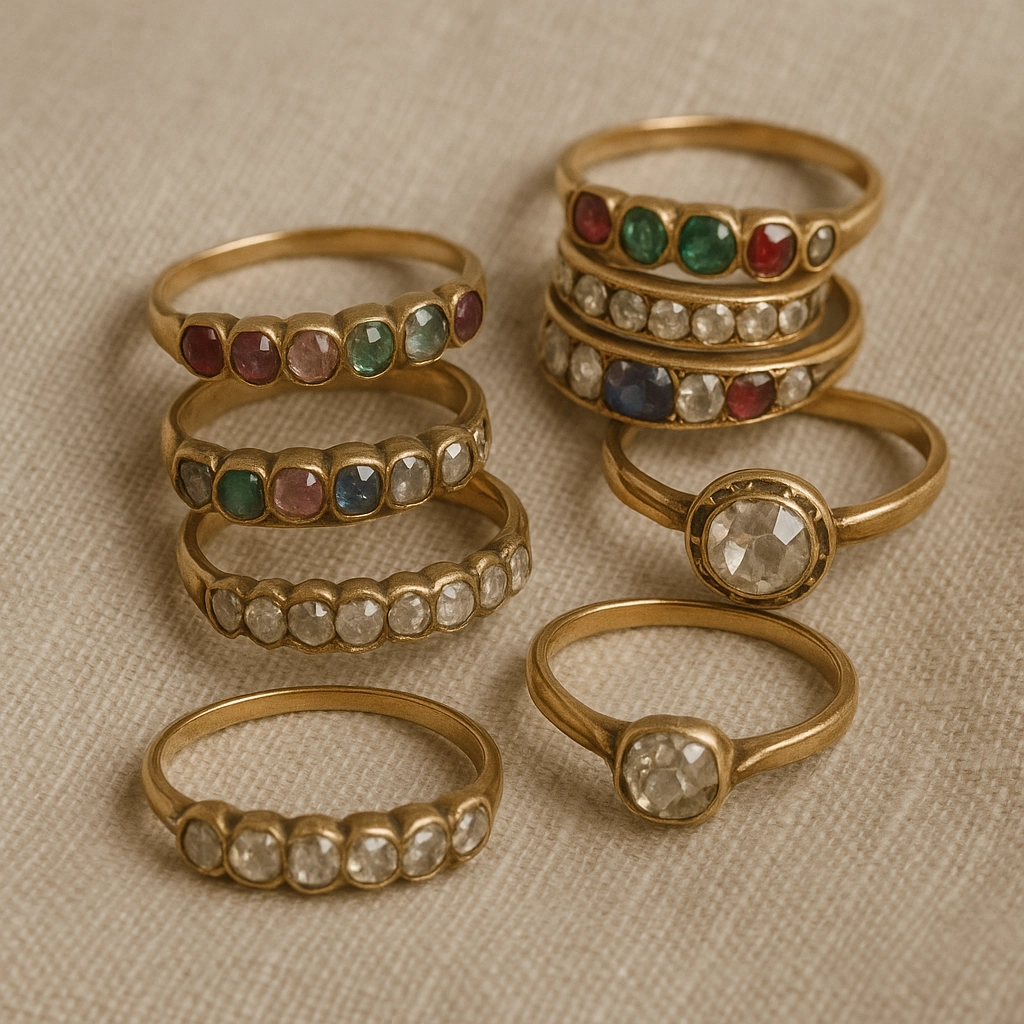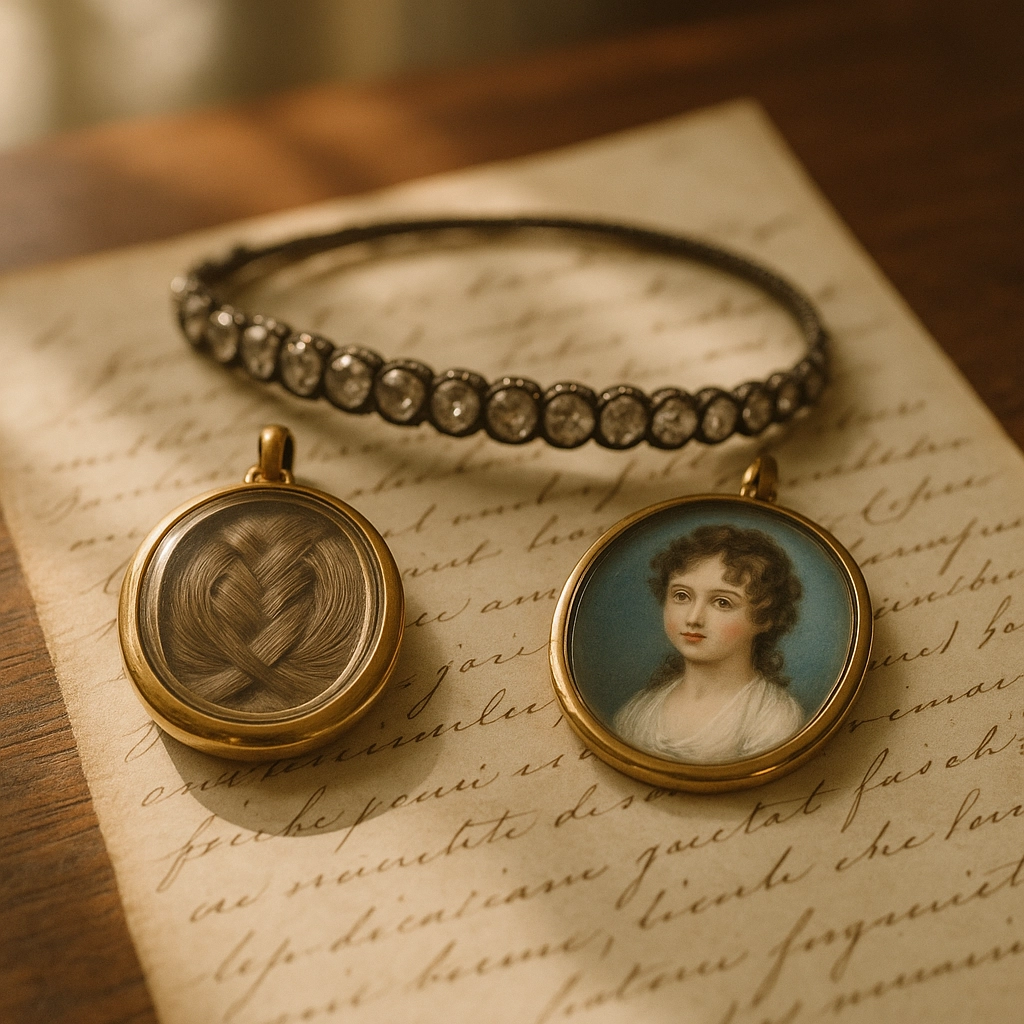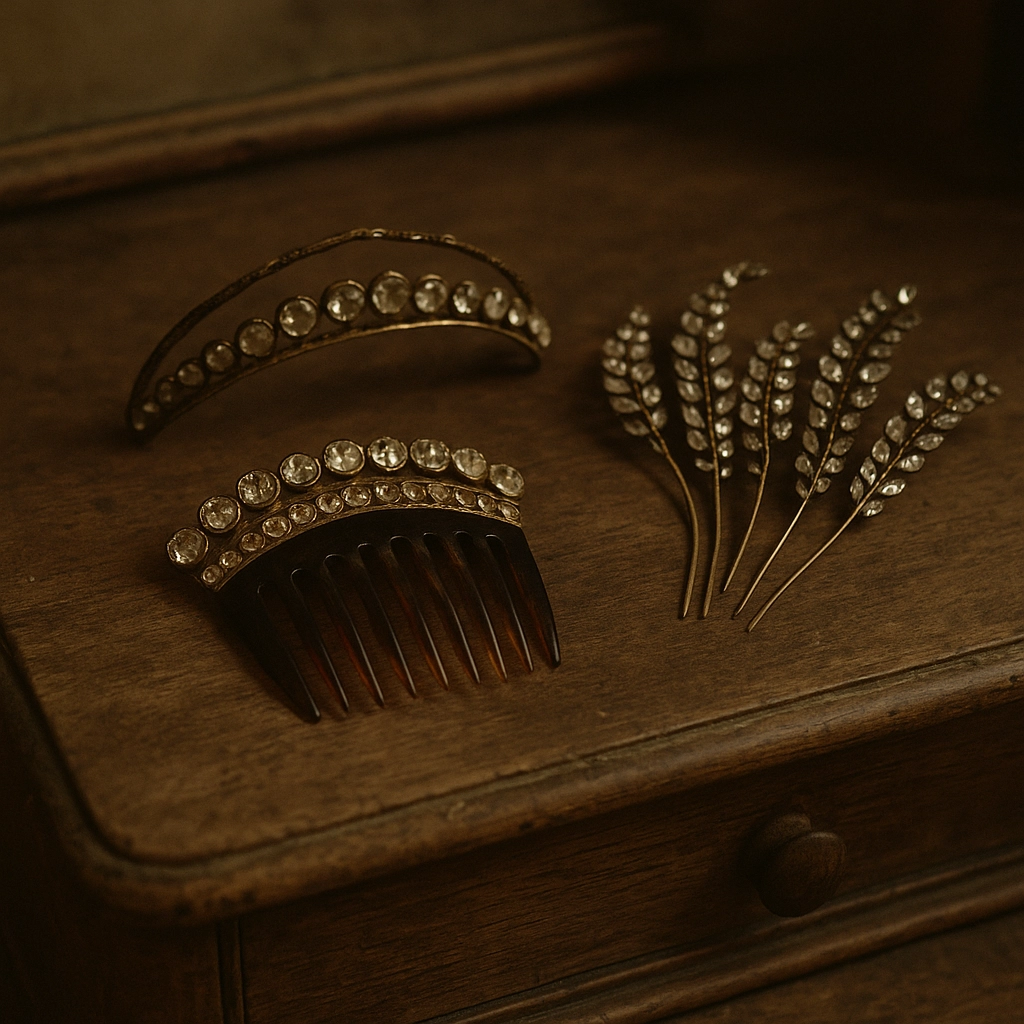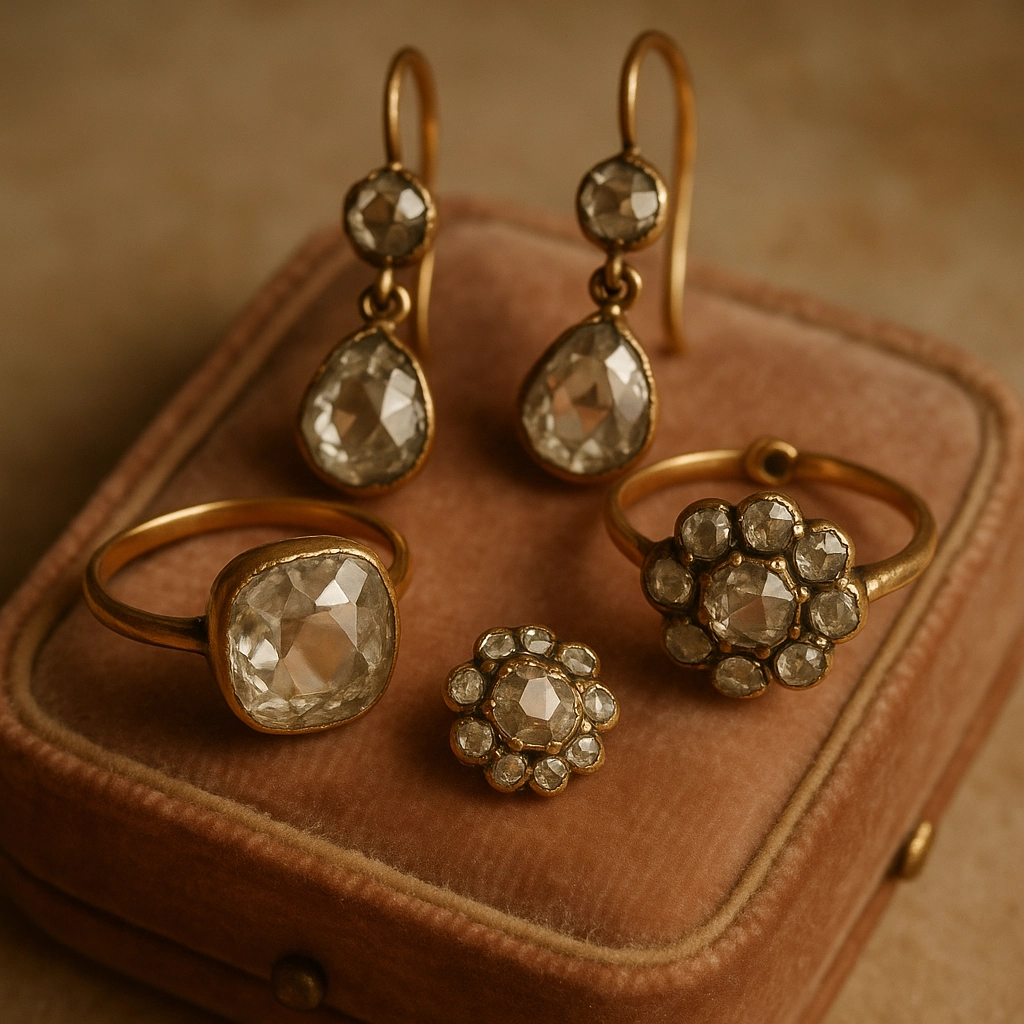The Georgian Era: Origins of Iconic Jewelry Styles - Part 1 of 4
Welcome to the first chapter of our Historic Jewelry Series here at Peter’s Vaults! Today, let’s step into the dazzling, slightly secretive world of Georgian jewelry—a period as ornate as the paintings hanging in any grand estate or historic home. If you’ve ever wondered what makes an antique piece truly “Georgian,” or just admired a cluster of rose-cut diamonds and thought, “huh, where did that style come from?”—this is where it all begins.
What Exactly Is Georgian Jewelry?
When I say “Georgian jewelry,” think of the era between 1714 and 1837—a huge stretch of time named for four consecutive British kings named George. This was the age of candlelit balls, powdered wigs, and ornate, handcrafted everything.
What’s really wild to me is that every single piece of Georgian jewelry was formed by hand. There were no machines stamping out settings or mass-producing chains. Instead, master goldsmiths and lapidaries worked under candlelight, shaping gold, silver, and gemstones with tools we’d now put in a museum. If you’re wearing or looking at a Georgian piece (lucky you!), you’re holding centuries of hands-on craftsmanship—and, honestly, not much in life feels cooler than that.
The Craft: Handwork and That “Imperfectly Perfect” Look
One quick way to spot Georgian jewelry? Look for signs of handmade artistry. The gold and silver pieces almost always have tiny irregularities—no two settings are identical, and the filigree or repoussé work isn’t factory-perfect. That’s actually part of their magic.
Georgian artisans didn’t have industrial casting: they fabricated each piece by hand, soldering delicate wire scrollwork, hammering metals into relief, or rolling gold into impossibly thin sheets. Repoussé and cannetille were the big show-off techniques. Repoussé (say it: ruh-poo-SAY) involved hammering designs into the back of metal, raising intricate motifs on the front. Cannetille, which got super popular in the later Georgian years—think 1820s and 1830s—looked like gold “embroidery,” lace, or filigree, with airy swirls that often seem like they’d float off the surface.
I always love the quirky “rough around the edges” aspect here: it means every Georgian jewel really is one-of-a-kind. Compare that with what you find in a modern jewelry store—they just don’t make ‘em like this anymore.

Gorgeous Materials, Clever Tricks
Let’s talk materials. The rich went for 18K (or higher) yellow gold and sterling silver, sometimes layering them—silver was often used for evening wear because diamonds looked more brilliant against a cool-toned background under candlelight. (Yes, literally, the jewelry was designed for maximum effect at night. Daytime pieces had different rules!)
If you’re peeking inside a Georgian locket or brooch and spot a brassy gold, you might actually see pinchbeck—a copper-zinc alloy that imitated gold really convincingly. This was the bling for the rising middle class, offering up affordable luxury way before “gold-plated” was a thing.
But the real secret sauce was foiling. Jewelers figured out that if you set rose-cut diamonds, garnets, or even colored glass on top of a shiny metallic foil (usually silver or colored to match the gem), it would bounce light around and make even modest stones look extravagant. It’s a detail you’ll see in museum collections: that glowing, almost magical, pop of color is thanks to these clever little engineering hacks.
Gemstones: The More, The Merrier
Georgian gems weren’t about today’s perfectly calibrated diamonds or ultra-clear sapphires. Instead, settings celebrated a mix: natural table-cut diamonds, chunky rose cuts, juicy garnets, slate-blue sapphires, velvety emeralds, and a ton of pearls. Turquoise and coral gave pieces color, while topaz and amber shone in candlelight.
If your family ever passed down a “foil-backed” colored gem ring, check if the stone looks a little bit “lit from within”—that’s Georgian info right there.
Stacking rings and acrostic rings were the fashion flex of their time. Acrostic rings spelled out secret messages—like “Regard” (Ruby, Emerald, Garnet, Amethyst, Ruby, Diamond). It’s the original instant message, but spelled out in precious stones. Romantic, right?

Motifs: Nature, Romance, and a Dash of Mystery
Georgian jewels are basically a Pinterest board of 18th- and early 19th-century life. Floral garlands, bows, hearts, birds, beetles, and even hands were everywhere. If you spot serpents or “clasped hands” on a ring or brooch, that’s a big clue you’re in Georgian territory.
Hair jewelry is another fascinating bit—yes, human hair, carefully plaited or woven into bracelets, necklaces, and mourning lockets. This wasn’t creepy; it was sentimental, either honoring lost loved ones or keeping a sweetheart close. Some jewel suites were made entirely from hair, finished with gold clasps and miniaturist paintings under glass. These pieces are deeply personal, and when you hold one, you feel the emotion and story behind it.
Portrait miniatures framed in pearls or garnets also flourished. Think of them as the 18th-century version of a locket with a photo inside—tiny, custom paintings meant to keep someone close, always.

Hairstyles and Seriously Extra Accessories
If you’ve ever seen old prints of Georgian balls, you’ll see hair stacked high, towering with adornments. To match the hair, jewelers produced tiaras, diadems, bandeaus, aigrettes, and jeweled hairpins designed to catch candlelight (and maybe attention from across the dance floor). Cluster rings, combs with foiled stones, and hair ornaments set with cut steel or paste (sparkling glass) became staples. Imagine how each piece must have danced in soft evening light.

The Rise of Paste Jewelry (The Ultimate Sparkle Hack)
Not everyone could splash out on diamonds, so jewelers in this era turned to paste—brilliantly cut glass stones that mimicked the real thing at a fraction of the cost. Paste jewelry allowed the middle class to emulate the wealthy, and some paste pieces are considered collectible masterpieces today. If you ever stumble across Georgian paste brooches or earrings, you’re seeing the roots of “faux” luxury—long before the days of cubic zirconia.
Diamonds: Early Cuts and Closed-Back Settings
Let’s geek out for a second about diamond cuts. The rose cut (flat on the bottom, domed with triangular facets on top), old mine cut (essentially an ancestor of today’s cushion cut), and the simple table cut dominated. They didn’t have the dazzling “fire” of modern brilliant cuts, but under candlelight? Stunning.
Diamonds and colored stones were almost always set in closed-back settings—with a foiled underside. That foiling technique gave stones more life and color, especially under evening lighting. If you open an old Georgian ring and see metal backing behind the stones, it’s typical of the time.

Famous Collectors and Legendary Pieces
While not every Georgian piece has a legendary story attached, some did make it to royalty and landed in major museum collections (like London’s Victoria & Albert Museum or Paris’s Musée des Arts Décoratifs). If you want to nerd out, research the “Georgian Girandole Earrings” in the British royal family’s jewel coffers—chandeliers of gold, diamonds, and pearls, all hand-wrought with drama in mind.
The Georgian Legacy: Why It Still Matters
The influence of the Georgian era continues far beyond its time. Today’s jewelry fans (myself included!) love these pieces for their combination of drama, imperfection, and ingenuity. Whether you spot a floral gold brooch at auction, a foiled garnet ring in your grandmother’s jewelry box, or a pair of dramatic chandelier earrings, those centuries-old techniques still stand up.
This is only the first deep-dive in our series tracing the evolution of historic jewelry styles. Next up, we’ll get into the lush, sentimental excess of the Victorian era. Have a favorite Georgian-style motif or an old heirloom at home? I’d love to hear about it—maybe even help you uncover its story.
Stay tuned for more sparkling chapters from Peter’s Vaults.
Cheers,
Peter
References: The V&A Museum Collections, Smithsonian, Gemological Institute of America, Christie’s, and 1stDibs archives among others.